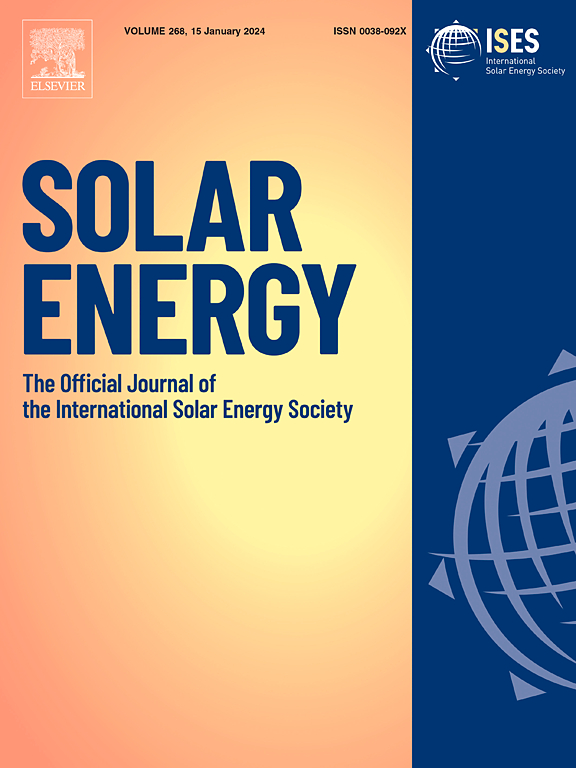相变材料类型对光电集热器性能和经济性影响的比较研究
IF 6
2区 工程技术
Q2 ENERGY & FUELS
引用次数: 0
摘要
混合和可再生能源系统,特别是光伏技术,在应对气候变化方面发挥着至关重要的作用。将相变材料(PCMs)集成到光伏-热(PVT)系统中,为改善热管理和能源效率提供了一种有前途的方法。采用数值分析方法研究了不同pcm的行为,为PVT集热器系统的热管理设计找到了有效的解决方案。基于实证研究和经过验证的综合数值模型,研究了不同相变材料作用下PVT集热器在不稳定天气条件下的性能。相变材料的影响分析包括评估PVT集热器的热行为、电性能和实施pcm的经济可行性。该研究使用Ansys Fluent软件模拟热行为,同时使用肖克利二极管方程对电输出进行建模,所得结果与实验数据非常吻合。分析了四种有机PCMs:猪油、RT58、RT35和正十八烷。所涉及的材料涵盖广泛的熔化范围,不同的潜热水平和单位成本。在热性能方面,正十八烷被证明是最好的,考虑到PVT集热器在峰值热负荷下比其他设计低6.1°C。因此,根据电力输出的估计,使用正十八烷的设计产生的电力最多,为1037 Wh。然而,所有设计的发电量相差在1%以内,因此强调了经济方面的重要性。猪油PCM被证明在很大程度上是最经济可行的,计算出的能源成本为0.0692€kWh - 1。然而,其相对较低的潜热和较宽的熔化范围可能是PVT系统热组件的限制因素。这些发现强调了在选择最适合PVT应用的PCM时,热性能、电输出和经济可行性之间的权衡。本文章由计算机程序翻译,如有差异,请以英文原文为准。
An impact of phase change material type on photovoltaic-thermal collector performance and economy: A comparative study
Hybrid and renewable energy systems, particularly photovoltaic technologies, play a crucial role in combating climate change. Integrating phase change materials (PCMs) into photovoltaic-thermal (PVT) systems offers a promising approach to improving thermal management and energy efficiency. The behavior of various PCMs was investigated using numerical analysis to identify an effective solution for the thermal management of PVT collector system design. Based on the empirical investigations and the validated, comprehensive numerical model, the study delved into the PVT collector’s performance under unstable weather conditions when subjected to different phase change materials. The impact analysis of phase change materials included assessing the PVT collector’s thermal behavior, electric performance, and the economic feasibility of implementing PCMs. The research utilized the Ansys Fluent software for simulating thermal behavior, while electrical output was modeled using the Shockley diode equation, yielding results in strong agreement with experimental data. Four organic PCMs were analyzed: pork fat, RT58, RT35, and n-octadecane. Involved materials cover a wide melting range, different latent heat levels, and unit costs. In terms of thermal performance, n-octadecane proved to be the best, considering that the PVT collector was up to 6.1 °C cooler than other designs at peak heat load. Consequently, based on the estimation of electrical outputs, the design with n-octadecane generated the most electricity, 1,037 Wh. However, the electric power production for all designs was within a 1 % difference, therefore emphasizing the importance of the economic aspect. The pork fat PCM proved to be most economically feasible by a large margin with a calculated levelized cost of energy in the amount of 0.0692 € kWh−1. However, its relatively low latent heat and wide melting range might be limiting factors for a thermal component of the PVT system. These findings underscore the trade-offs between thermal performance, electrical output, and economic feasibility in selecting the most suitable PCM for PVT applications.
求助全文
通过发布文献求助,成功后即可免费获取论文全文。
去求助
来源期刊

Solar Energy
工程技术-能源与燃料
CiteScore
13.90
自引率
9.00%
发文量
0
审稿时长
47 days
期刊介绍:
Solar Energy welcomes manuscripts presenting information not previously published in journals on any aspect of solar energy research, development, application, measurement or policy. The term "solar energy" in this context includes the indirect uses such as wind energy and biomass
 求助内容:
求助内容: 应助结果提醒方式:
应助结果提醒方式:


